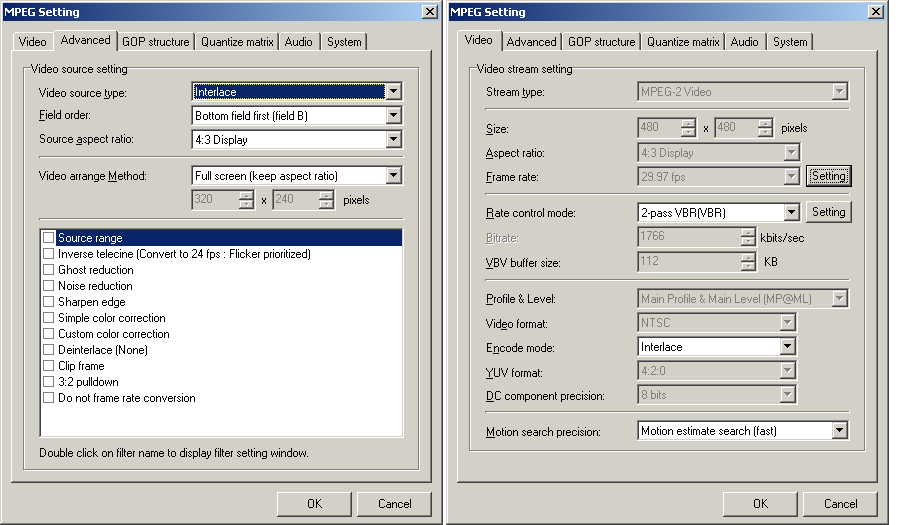Just burnt my first SVCD from a 16:9 interlaced DV-AVI source. I used a simple .avs script and standard SVCD-NTSC template in TMPGEnc 2.5 Plus. The latter was set to produce interlaced output. I set average bitrate to 1700+ kbts/sec. Here is the .avs script:
Loadplugin("C:\Program Files\AviSynth 2.5\plugins\msharpen110b2\MSharpen.dll")
DirectShowSource("D:\MiniDV\Panyuzoo-trimmed.avi")
bilinearresize(480,360)
MSharpen()
AddBorders(0,60,0,60).
When I played this back on my TV, the interlacing lines were very visible during fast motion and even in still scenes, edges where jagged.
Any idea as to why interlacing hadn't disappeared?
Appreciate your help.
+ Reply to Thread
Results 1 to 12 of 12
-
-
you may have encoded the wrong field order
"Each problem that I solved became a rule which served afterwards to solve other problems." - Rene Descartes (1596-1650) -
-
I think it's because of the bilinearresize/addborders combination. You are resizing frames that consist of fields from two different points in time and then adding borders on top and bottom and then telling the encoder to encode with 480 scan lines which no longer line up with the original scan lines that you shrunk. You need to separate the fields, then resize and add borders, then weave them back together and encode interlaced.
"Shut up Wesley!" -- Captain Jean-Luc Picard
Buy My Books -
Replace BilinearResize() with:
LeakKernelBob(Order=0)
LanczosResize(480, 360) #fewer moire artifacts and sharper than bilinear
# put MSharpen() here if you need it, not after Weave()
SeparateFields()
SelectEvery(4,0,3)
Weave() -
Goes back to the old saying: "If it isn't broke, don't fix it".
The original file was fine before all the special modifications. Vertical resizing of interlace material causes the greatest problems. Handle with care. Conversion to 352x576 (PAL) or 352x480 (NTSC) is usually harmless. -
Thanks everyone for you help. It makes perfect sense that fields would get messed up with a resize.
I have LeakKernelDeint package, but have never used ...Bob(). How does it work?
And also, SelectEvery(4,0,3), I believe means: select fields 0,3,4,7,8,11.... But what is the purpose and how do you arrive at the parameters?
Thanks again. -
LeakKernelBob(order=0 for BFF, order=1 for TFF) performs a smart BOB deinterlace, creating two progressive frames from one interlaced frame. For still parts of the picture it copies both fields to each frame. For parts where there's motion it does some smart interpolation of the fields. You now have two progressive frames for each interlaced frame in the original.
You resize at this stage while you have progressive frames.
SeparateFields() splits each of those two progressive frames into two fields. You now have four fields.
SelectEvery(4, 0, 3) says for every group of 4 fields (or frames if you had frames) select fields 0 and 3 (throw out fields 1 and 2). field 0 is the top field from the first progressive frame, field 3 is the bottom field from the second progressive frame (or vice versa depending on the current field order).
Weave() weaves the two remaining fields back into an interlaced frame.
Code:Ii -> P1 P2 (resize here) -> P1t P1b P2t P2b -> P1t P2b -> Oi Ii = input frame, interlaced P1 = Progressive frame from one field of Ii P2 = Progressive frame from other field of Ii P1t = top field from P1 P1b = bottom field from P1 P2t = top field from P2 P2b = bottom field from P2 O = interlaced output frame
-
jagabo, thank you for that explanation. I'll try this tomorrow and report back here.
-
Worked like a charm. Interlace lines are gone! The overall quality leaves much to be desired though, but I guess that's a function of the low bitrate.Originally Posted by jagabo
-
SVCD is rather low quality. But 60 lines of black at the top and bottom should help (black borders take up hardly any bits).
I don't remember -- does SVCD support anamorphic 16:9? If that's the case you can simply resize to 480x480 and set the 16:9 flag. -
I don't think it's part of SVCD standard, but I've heard some players can support it. Mine doesn't.
Similar Threads
-
Video not visible
By bluechip0032 in forum Software PlayingReplies: 2Last Post: 15th Aug 2010, 22:43 -
DVDlab Pro: Text set as visible isnīt visible in the result
By Alex89 in forum Authoring (DVD)Replies: 14Last Post: 12th Aug 2010, 07:09 -
Best Method of De-interlacing Mini-DV AVI files
By Dave2ic in forum Video ConversionReplies: 20Last Post: 6th Jun 2010, 05:54 -
Good Video Explaining Interlacing and De-Interlacing
By Soopafresh in forum Newbie / General discussionsReplies: 3Last Post: 14th Aug 2008, 19:50 -
Video not visible in editing software/visible in Media Player
By kb1985 in forum Newbie / General discussionsReplies: 1Last Post: 1st Aug 2007, 18:21




 Quote
Quote